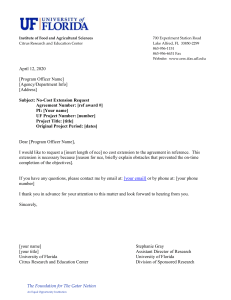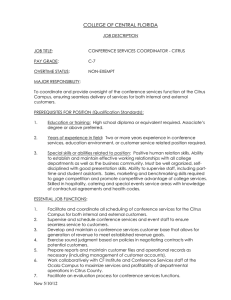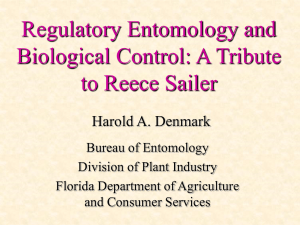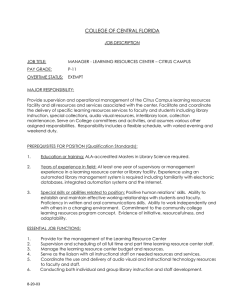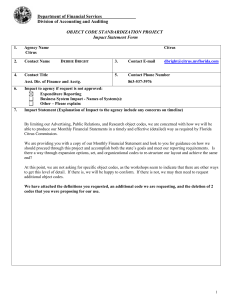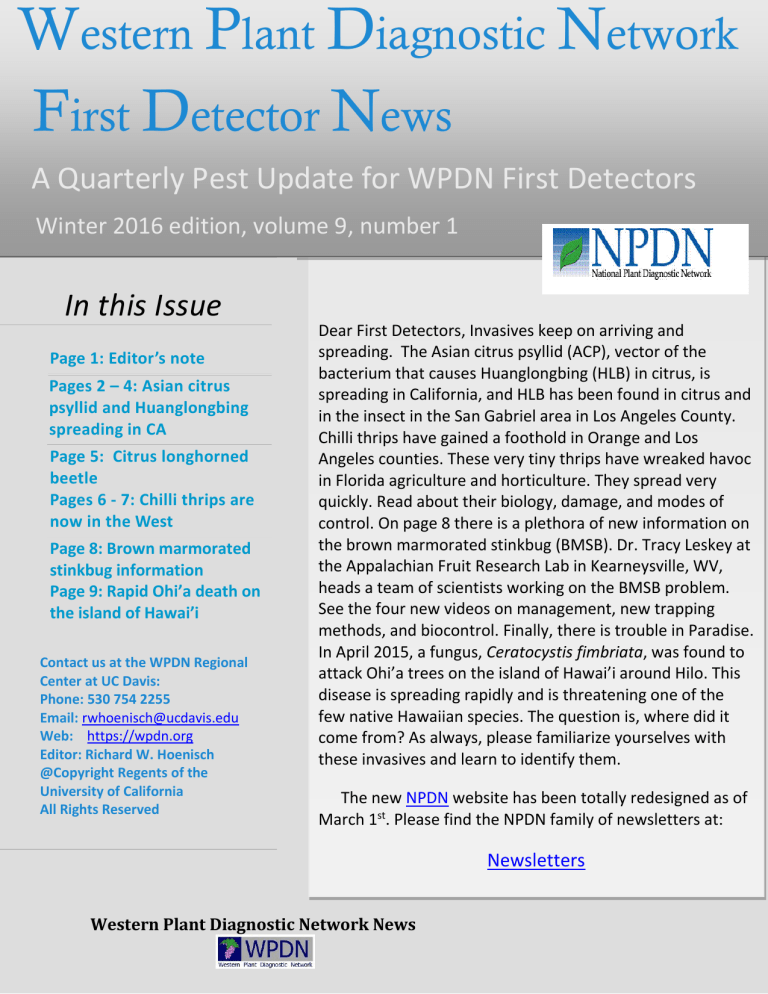
Western Plant Diagnostic Network
First Detector News
1
A Quarterly Pest Update for WPDN First Detectors
Winter 2016 edition, volume 9, number 1
In this Issue
Page 1: Editor’s note
Pages 2 – 4: Asian citrus
psyllid and Huanglongbing
spreading in CA
Page 5: Citrus longhorned
beetle
Pages 6 - 7: Chilli thrips are
now in the West
Page 8: Brown marmorated
stinkbug information
Page 9: Rapid Ohi’a death on
the island of Hawai’i
Contact us at the WPDN Regional
Center at UC Davis:
Phone: 530 754 2255
Email: rwhoenisch@ucdavis.edu
Web: https://wpdn.org
Editor: Richard W. Hoenisch
@Copyright Regents of the
University of California
All Rights Reserved
Dear First Detectors, Invasives keep on arriving and
spreading. The Asian citrus psyllid (ACP), vector of the
bacterium that causes Huanglongbing (HLB) in citrus, is
spreading in California, and HLB has been found in citrus and
in the insect in the San Gabriel area in Los Angeles County.
Chilli thrips have gained a foothold in Orange and Los
Angeles counties. These very tiny thrips have wreaked havoc
in Florida agriculture and horticulture. They spread very
quickly. Read about their biology, damage, and modes of
control. On page 8 there is a plethora of new information on
the brown marmorated stinkbug (BMSB). Dr. Tracy Leskey at
the Appalachian Fruit Research Lab in Kearneysville, WV,
heads a team of scientists working on the BMSB problem.
See the four new videos on management, new trapping
methods, and biocontrol. Finally, there is trouble in Paradise.
In April 2015, a fungus, Ceratocystis fimbriata, was found to
attack Ohi’a trees on the island of Hawai’i around Hilo. This
disease is spreading rapidly and is threatening one of the
few native Hawaiian species. The question is, where did it
come from? As always, please familiarize yourselves with
these invasives and learn to identify them.
The new NPDN website has been totally redesigned as of
March 1st. Please find the NPDN family of newsletters at:
Newsletters
Western Plant Diagnostic Network News
Asian Citrus Psyllid and Huanglongbing Spread in California
2
Photo by David Littschwager
Photo courtesy of UF/IFAS
Photo by Douglas L. Caldwell
The Summer 2015 newsletter reported the spread of Asian citrus psyllid (ACP) in California and Arizona.
The problem continues with ACP, Diaphorina citri, a sap-sucking, hemipteran bug in the family, Psyllidae;
Order: Hemiptera ; Suborder: Sternorrhyncha . It is an important pest of citrus being one of only two
known vectors of the serious bacterial citrus disease, Huanglongbing (HLB). HLB is called “citrus greening”
in Florida. The ACP has been spreading in California and Arizona. For details visit the CDFA ACP/HLB
website. ACP/HLB has been responsible for destroying thousands of acres of citrus in Florida with
devastating results to the state's citrus growing counties. The insect has spread to California and many
Southern California counties have imposed full quarantines after the psyllid was found at several sites. The
threat to California's $2 billion citrus industry is serious. It is widely distributed in southern Asia and has
spread to other citrus growing regions. ACP damages citrus when its nymphs feed on new shoots and
leaves (flush growth). They remove sap from the plant tissue and inject a salivary toxin as they feed. This
deforms new leaves by twisting and curling them and inhibits or kills new shoots by burning them back.
There are many other insect pests that can cause twisting of leaves such as aphids, citrus leafminer, and
citrus thrips. The twisting of leaves does not harm trees and can be tolerated, but the burning back of new
flush will retard growth of young trees that are not yet 5 years old. Most importantly, the ACP can kill citrus
trees through its feeding activity if the insect infects the tree with the bacterium that causes HLB. The
nymphal and adult stages can carry the bacterium, Candidatus Liberibacter asiaticus. The “Candidatus ”
prefix means the bacterium has not yet been cultured (see Koch's Postulates ). The nymphal and adult
stages can carry and transmit the bacterium that multiplies within the insect’s salivary glands. Please see
the WPDN Summer 2010 and Winter-Spring 2012 newsletters for the first reports of ACP and HLB.
An adult ACP feeding
Western Plant Diagnostic Network News
These tiny
parasitic wasps,
Tamarixia
radiata, feed on
and kill Asian
citrus psyllids.
Photograph by David Liittschwager
ACP nymphs in new citrus
ACP nymphs excreting waxy tubules
growth
The ACP county-wide quarantines are now in place in Imperial, Los Angeles, Orange, Riverside, San
Bernardino, San Diego, Santa Barbara, Tulare and Ventura Counties, with portions of Alameda, Fresno,
Kern, Madera, Merced, San Benito, San Francisco, San Joaquin, San Luis Obispo, San Mateo, Santa Clara,
and Stanislaus counties also under quarantine. See ACP Treatment Information to realize the spread of
ACP. The quarantine prohibits the movement of citrus and curry leaf tree nursery stock, including all plant
parts except fruit, out of the quarantine area and requires that all citrus fruit be cleaned of leaves and
stems prior to moving out of the quarantine area. An exception may be made for nursery stock and
budwood grown in USDA-approved structures which are designed to keep ACP and other insects out.
Residents with backyard citrus trees in the quarantine area are asked not to transport or send citrus fruit or
leaves, potted citrus trees, or curry leaves from the quarantine area.
For nearly eight years, California’s citrus industry has been aware of the possibility of the Asian citrus 3psyllids
infected with the Huanglongbing bacteria migrating across the southern part of the state and heading north.
ACP/HLB could infect commercial citrus trees and devastate the state’s citrus industry. HLB was first found in
California in March, 2012, in Hacienda Heights, Los Angeles County. The owner of the property had several
citrus varieties grafted onto the one citrus tree. He purportedly “self-imported (smuggled)” citrus budwood
infected with HLB from Asia, and grafted it onto his tree. The bacterium is graft transmissible. The whole tree
became infected with HLB and was removed and destroyed.
A group of psyllids found to be infected with the bacterium have been found since the middle of 2015 in the
Southern California community of San Gabriel and La Puente, the latest early February, 2016. The La Puente
psyllid was captured alive sometime in December, and the California Department of Food and Agriculture
notified industry officials on December 21, 2015, that it had tested positive for HLB. In addition, a dozen HLBinfected citrus trees have been found since July within a few blocks of each other in some San Gabriel
neighborhoods, about 14 miles to the northwest, La Puente.
Below please find links and YouTube presentations on ACP/HLB.
Excluding a Bad Citrus Pest from California
Save Our Citrus: CDFA Protects Against the threat of Huanglongbing (Citrus Greening)
Detecting Asian citrus psyllid
An Overview of the Asian Citrus Psyllid Problem
Save Our Citrus
Citrus Diseases
Asian Citrus Psyllid in Arizona
Infestations of the Asian citrus psyllid have been detected in western Arizona in Bullhead City, Lake Havasu City,
Parker and, to the greatest extent, in Yuma County, leading to a quarantine in those areas. People and businesses
are prohibited from moving citrus fruits, citrus plants or plant parts from the area without treatment or other
measures to reduce the risk of spreading the insect. Psyllids, the size of a tip of a ballpoint pen, were also found at
the U.S. border crossing at Nogales in a shipment of limes in June 2013 and at the Port of Mariposa at the U.S.Mexican border in January 2013 in a bag of citrus leaves brought from Mexico.
Citrus is a $37 million industry in Arizona. Officials from the U.S. Department of Agriculture and the state
Department of Agriculture had been keeping up with detecting and eradicating the insect in Arizona by spraying.
Huanglongbing (HLB) has not been detected in Arizona. The Yuma district has desert area to the east, north, and
south. However ACP can get around, hitchhike, get blown by the wind, etc.
Image courtesy Bugwood.org
Western Plant Diagnostic Network News
Asian citrus psyllid
Yuma County AZ
4
Photo courtesy of u-pick citrus
Before you give citrus, there are four things you should
know to gift smart:
Photo by P. Barkley
Home-grown citrus
Photo courtesy of USDA
ACP swarming on a citrus leaf
Photo by H.D. Catling, Bugwood.org
Orange fruit demonstrating “greening”
1. Be Aware of Quarantines. If you are thinking about giving
citrus fruit, plants, or items made with citrus (such as floral
arrangements, wreaths, potpourri or seasonings like kaffir
lime leaves) be sure not to move them from quarantined
states or territories. Not only are you risking spreading citrus
diseases by transporting citrus outside of these areas, but
it’s also against the law. Learn more about ACP quarantines.
2. Check the Citrus Supplier. Be a savvy buyer. Gift citrus fruit
sold in a regulated state must be packed in a certified
packinghouse and accompanied by a USDA certificate.
Commercial fruit packers, Internet shippers and roadside
vendors within regulated states should be able to prove they
are in compliance with the federal quarantine. Before you
buy, ask the vendor if their product is in compliance. Learn
more about ACP quarantines .
3. Keep Homegrown Citrus at Home. Help reduce the spread
of citrus diseases by not moving your homegrown citrus fruit
or plants across state lines. Enjoy your fruit with friends and
neighbors, but be sure to obtain a federal certificate if
you’re thinking of transporting your citrus outside of your
state. To inquire about transporting your citrus out of state,
contact your local State Plant Health Directors.
4. Avoid Fines and Penalties. Because citrus diseases have
destroyed millions of acres of citrus around the world, they
present an immediate and urgent threat to America. If you
knowingly purchase citrus in violation of quarantine
regulations and requirements, the penalties you could incur
range from $1,100 to $60,000 per violation. If you suspect
citrus is being moved improperly, report your concerns to
USDA’s Smuggling Interdiction and Trade Compliance (SITC)
toll-free hotline at (800) 877-3835.
From: Gift Citrus Smart
Photo by Julie Millowick
Orange tree in decline from HLB
Western Plant Diagnostic Network News
Dead orange grove from HLB
5
Citrus longhorned beetle
While we are on the subject of citrus pests, the citrus longhorned beetle, Anoplophora chinensis, has found its
way to the mainland United States. It is native to China, Japan, and Korea. Each female citrus long-horned
beetle can make up to 200 eggs after mating, and each egg is separately deposited in tree bark. After the beetle
larvae hatches, it chews into the tree, forming a tunnel that is then used as a place for beetle pupation (the
process of growing from larvae to adult). From egg-laying to pupation and adult emergence can take twelve to
eighteen months. Infestations by the beetle can kill many different types of hardwood trees as well as citrus
trees, pecan, apple, Australian pine, hibiscus, sycamore, willow, pear, mulberry, pigeon pea, Chinaberry, poplar,
litchi, kumquat, Japanese red cedar, oak, and Ficus. Please see the USDA Citrus Longhorned Beetle Species
Profile.
Citrus longhorned beetle, Anoplophora chinensis, is in the same genus as the Asian longhorned beetle,
Anoplophora glabripennis.
Photo courtesy of fitosanitario.it
Photo courtesy of Insectarium de Montréal
Citrus Longhorned Beetle
Anoplophora chinensis
Asian Longhorned Beetle
Anoplophora glabripennis
What differences do you see?
Photo courtesy of PPQ
Photo courtesy of USDA
Last instar larva of CLB
Western Plant Diagnostic Network News
Last instar larva of ALB
6
The citrus long-horned beetle was first discovered in the U.S. in April 1999, when a single beetle was found in
a nursery greenhouse in Athens, Georgia on certain bonsai trees imported from China. More seriously, the
beetle was later discovered on 9 August 2001, at a Tukwila, Washington nursery near Seattle in a shipment
from Korea of 369 bonsai maple trees. Three of the beetles were captured at the nursery, including a mated
female ready to lay eggs, but when the bonsai trees were dissected, eight larvae exit tunnels were found,
indicating that five more might have escaped into the surrounding community. Those five could lead to
thousands of others because females lay 200 eggs at a time beneath the bark of trees. Because this beetle
may have other outlying infestations that are yet to be discovered, it is important not to move firewood,
even in areas with no known pest infestations. The CLB was found in Essex, England, in 2008. It is now
invasive in the area. See their experience with CLB in this YouTube: Citrus Longhorn Beetle in England.
Photos by Lance Osborne of UF/IFAS
Chilli Thrips are in the West!
Just molted adult chilli thrips
Female (larger) and male
chilli thrips
Western flower thrips (right)
compared to chilli thrips (left)
The chilli thrips, Scirtothrips dorsalis Hood, 1919, is an extremely successful invasive species of pest-thrips
which has expanded rapidly from Asia over the last twenty years, and is gradually achieving a global
distribution. It has most recently been reported in St. Vincent (2004) Florida (2005), Texas (2006), Puerto Rico
(2007), and California (2015). Chilli thrips first were found established in CA in the residential property on roses,
in Fullerton Orange County, on July 27, 2015. Later, on October 20, 2015 they were discovered in Los Angeles
County, in LA County Arboretum, again on roses. It is a pest of economic significance with a broad host range,
with prominent pest reports on crops including pepper, mango, citrus, strawberry, grapes, cucumber,
asparagus, cotton, tea, camellias, peanuts, blueberry, and roses. Chilli thrips appear to feed preferentially on
new growth, and infested plants usually develop characteristic wrinkled leaves, with distinctive brown scarring
along the veins of leaves, the buds of flowers, and the calyx of fruit. Feeding damage can reduce the sale value
of crops produced, and in sufficient numbers, kill plants already aggravated by environmental stress. This thrips
has also been implicated in the transmission of three tospoviruses, but there is some controversy over its
efficiency as a vector. This thrips has a rapid life cycle, and can develop from egg to adult in slightly less than
two weeks under optimal weather conditions. The small size (< 2 mm or 0.08 “) of the chilli thrips life stages
and rapid movement make it difficult to detect this insect in fresh vegetation. See the University of Florida chilli
thrips pest alert, and UF Chilli Thrips PowerPoint for great photos of the life cycle and damage to plants.
Western Plant Diagnostic Network News
7
Curling of pepper leaves caused
by feeding of chilli thrips
Chilli thrips on rose in Anaheim CA
Photo by Scott Ludwig
Photo by Dr. Lance Osborn and Gaye Hammond.
Photo by roseseek
Photo by M. A. Ciomperlik, APHIS, USDA
Chilli Thrips Damage
Severe chilli thrips foliar damage on
rose
Chilli thrips damage on Rhaphiolepis indica,
India hawthorn
Thrips are slender insects with fringed
wings in the order Thysanoptera from
the Greek, thysanos ("fringe") + pteron
("wing") Note the fringed wings on the
adult stage. Like the words sheep, deer
and moose, the word thrips is used for
both the singular and plural forms, so
there may be many thrips or a single
thrips. The word thrips is from the
Greek “thrips”, meaning "woodworm.”
As hemimetabolous insects, the
Thysanoptera do not actually undergo
complete metamorphosis. For more on
chilli thrips, visit: Symptoms on Roses,
Chilli Thrips Control Strategies, Chilli
Thrips: A Landscaper’s Guide, and UC
IPM Thrips Management.
Western Plant Diagnostic Network News
8
Brown Marmorated Stink Bug Information
More than 50 researchers from 10 institutions across the United States work together on the BMSB project
team. With funding from USDA’s Specialty Crop Research Initiative, the team of researchers has mobilized to
form a defense against the invasive pest BMSB. The team are working to find management solutions for
growers, seeking strategies that will protect our food, our environment, and our farms. Take time and navigate
through this excellent website!
New Videos Released on Brown Marmorated Stink Bug
Tracking the Brown Marmorated Stink Bug This video series shows growers and others how to identify BMSB,
why this pest is important in agriculture, and what’s at stake if we don’t stop it. Update: We created four new
videos to address recent developments in monitoring, trapping, management, and biological control.
Asian wasp, enemy of stink bugs, found in the United States The Asian wasp Trissolcus japonicus has been
found in the wild in the United States. The wasp, native to the regions of Asia where the brown marmorated
stink bug (BMSB) originates, is known to attack the eggs of BMSB and possibly other stink bugs.
BMSB Damage Gallery View our photo gallery of BMSB damage in apples, pears, cherries, corn, tomatoes, and
more.
Vegetables This new guidance document for vegetable growers provides a synopsis of what researchers have
learned so far and management recommendations using an integrated approach. Available in English and
Spanish.
Available Positions Learn about currently open positions on the Brown Marmorated Stink Bug project.
Stink Bug Continues Its Spread Northwest growers should be on the lookout for brown marmorated stink bug.
Source: Good Fruit Grower, December 7, 2015.
Diagnosing Stink Bug Injury to Vegetables In the mid-Atlantic, vegetable crops are attacked by several different
stink bug species. The primary pest species include the brown marmorated stink bug, brown stink bug, green
stink bug, and harlequin bug. Source: Virginia Cooperative Extension, November 2015.
Stink Bugs: Attacking Orchards, Invading Harrison Homes Red Delicious apples are their favorite food this fall;
attics and walls are their favorite places to tuck in for the winter. Source: Harrison Patch, October 12, 2015.
Biological control program is being developed for brown marmorated stink bug from California Agriculture
Trissolcus japonicus recently found in Washington State from the Jentsch Lab at Cornell
Western Plant Diagnostic Network News
The Asian Wasp, Trissolcus japonicus
Rapid ʻŌhiʻa Death (ROD) on Hawai’i
Caused by the fungus Ceratocystis fimbrata
9
Photo courtesy CTAHR
Photo by Alan L
Symptoms of Rapid ʻŌhiʻa Death ROD, caused by the
fungus Ceratocystis fimbriata
A healthy ʻōhiʻa tree with blossoms
A highly virulent disease is spreading through Hawaii’s ohi’a forests on Hawaii Island, especially near Hilo and Puna
District. Ohi’a lehua, Metrosideros polymorpha, is a species of flowering evergreen tree in the myrtle family,
Myrtaceae, that is endemic to the six largest islands of Hawai’i It produces a brilliant display of flowers, made up of
a mass of stamens, which can range from fiery red to yellow. Many native Hawaiian traditions refer to the tree and
the forests it forms as sacred to Pele, the volcano goddess, and to Laka, the goddess of hula. ʻŌhiʻa trees grow
easily on lava, and are usually the very first plants to grow on new lava flows. ʻŌhiʻa trees cover 865,000 acres and
is considered by many to be the most important tree in Hawaiʻi. Half of the native trees on Hawaiʻi Island are ʻōhiʻa.
Native birds and tree snails, many of them endangered, live and feed on them. Their canopy protects the
innumerable smaller trees and native shrubs, creating the watershed that recharges our water supply.
A form of the fungus, Ceratocystis fimbriata, was identified in April 2015, as the cause of widespread mortality in
Ohi'a trees in the Puna District on the island of Hawai'i. The source of the outbreak is currently unknown.
Ceratocystis fimbriata, was originally described in Hawai’i on the sweet potato in 1890. It has since been found on a
wide variety of annual and perennial plants. It is a large, diverse complex of species that cause wilt-type diseases of
many economically important plants. This is a new strain of the fungus and the first record of any Ceratocystis
species affecting ʻōhiʻa. It is not yet known whether this widespread occurrence of ʻōhiʻa mortality results from an
introduction of an exotic strain of the fungus or whether this constitutes a new host of an existing strain. This
disease has the potential to kill ʻōhiʻa trees statewide. See the Hawai'i Forestry Extension for a journal of the
epidemic and work to understand and contain the disease. Crowns of affected trees turn yellowish (chlorotic) and
subsequently brown within days to weeks; dead leaves typically remain on branches for some time. On occasion,
leaves of single branches or limbs of trees turn brown before the rest of the crown of becomes brown. Recent
investigation indicates that the pathogen progresses up the stem of the tree. Trees within a given stand appear to
die in a haphazard pattern; the disease does not appear to radiate out from already infected or dead trees. Within
two to three years nearly 100% of trees in a stand succumb to the disease. Currently, there is no known method of
protecting ‘ōhi‘a trees from becoming infected with Ceratocystis nor an effective treatment to cure trees that
exhibit symptoms of the disease. To reduce the spread of Ceratocystis, landowners should not transport wood of
affected ‘ōhi‘a trees to other areas. The pathogen may remain viable for over a year in dead wood.
Please see: Seeding the future of the ʻōhiʻa tree from the University of Hawai’i, Hawai'i Department of Agriculture
quarantine, ROD pest alert, and Understanding and stopping rapid ʻŌhiʻa death.
Western Plant Diagnostic Network News

